Business Environment: Detailed Analysis of British Airways Report
VerifiedAdded on 2019/12/03
|14
|4342
|204
Report
AI Summary
This report provides a comprehensive analysis of the business environment of British Airways. It begins with an introduction to the business environment and its impact on organizations, followed by a case study of British Airways. The report examines the different types of organizations, focusing on British Airways as a case example, and analyzes its mission, vision, and objectives. It identifies key stakeholders, including customers, employees, competitors, and suppliers, and assesses their impact on the airline's operations. The report also explores British Airways' responsibilities and strategies to meet stakeholder expectations. Furthermore, it delves into the economic systems, including capitalism, socialism, and communism, and their implications. It examines the impact of fiscal and monetary policies, such as interest rates and tax rates, on businesses. The report also analyzes the impact of competition policy and regulatory mechanisms on British Airways' activities, including market structure, pricing, and demand within the airline industry. It concludes with an overview of global factors, including trade regimes and the policies of the European Union, that influence British Airways.
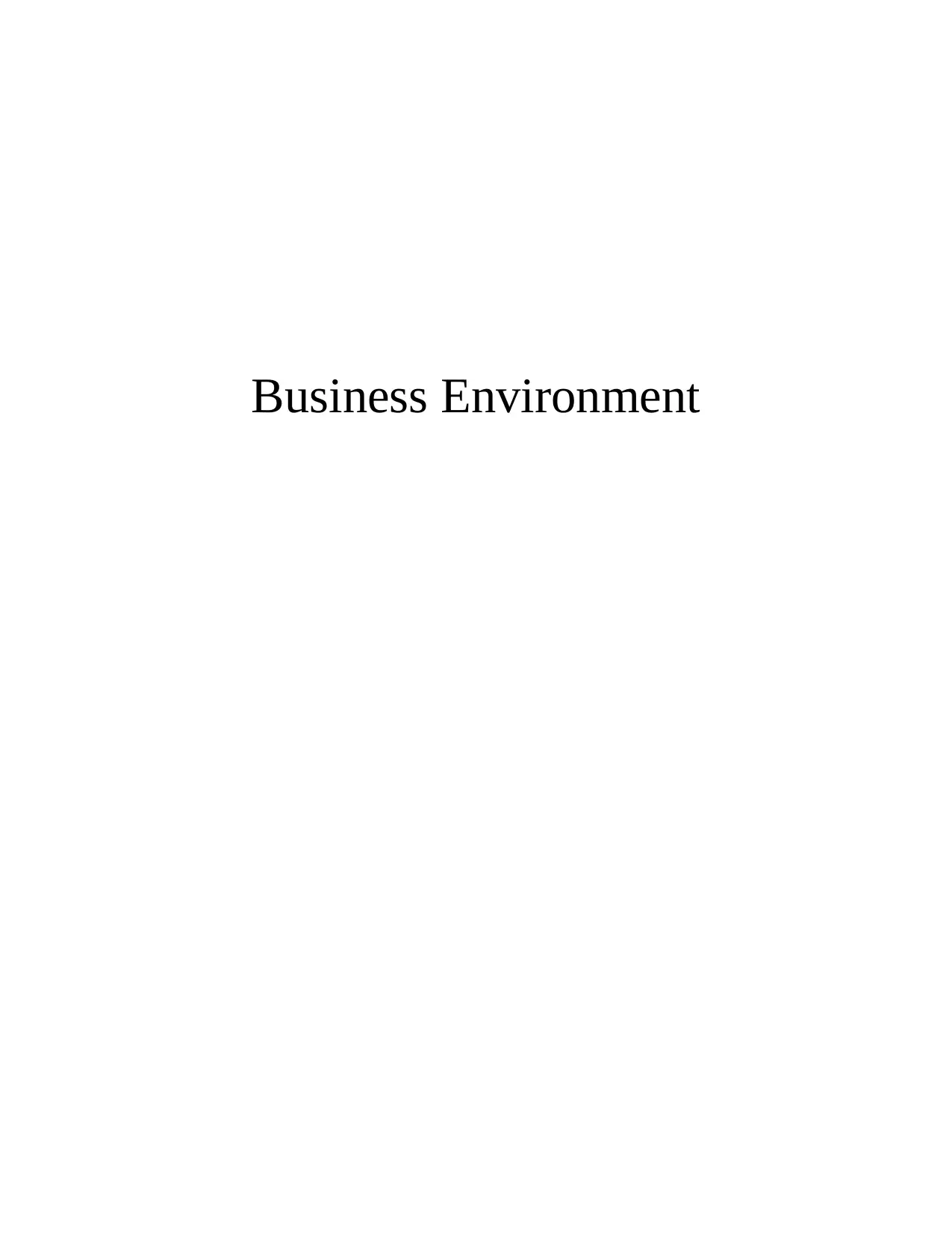
Business Environment
Paraphrase This Document
Need a fresh take? Get an instant paraphrase of this document with our AI Paraphraser
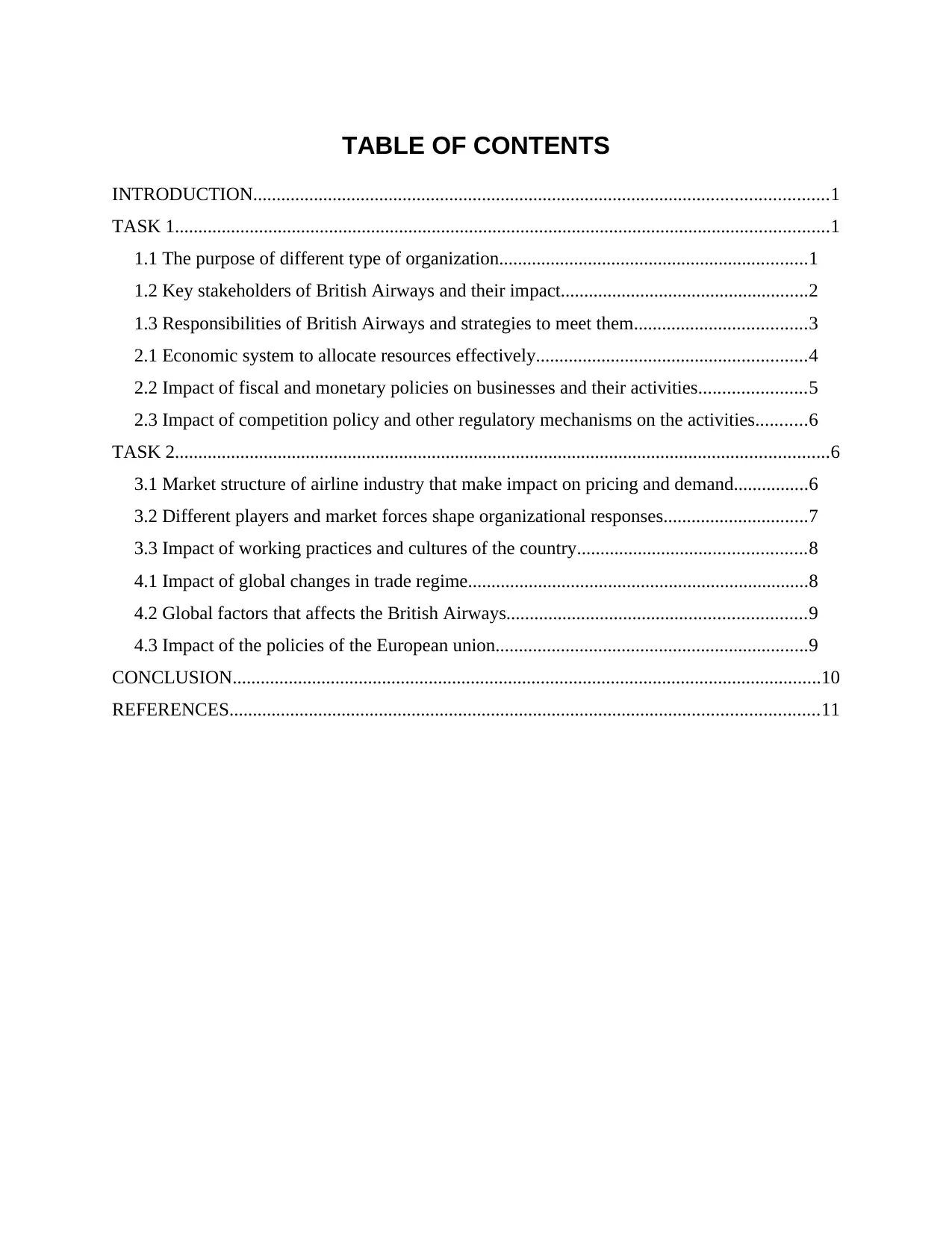
TABLE OF CONTENTS
INTRODUCTION...........................................................................................................................1
TASK 1............................................................................................................................................1
1.1 The purpose of different type of organization..................................................................1
1.2 Key stakeholders of British Airways and their impact.....................................................2
1.3 Responsibilities of British Airways and strategies to meet them.....................................3
2.1 Economic system to allocate resources effectively..........................................................4
2.2 Impact of fiscal and monetary policies on businesses and their activities.......................5
2.3 Impact of competition policy and other regulatory mechanisms on the activities...........6
TASK 2............................................................................................................................................6
3.1 Market structure of airline industry that make impact on pricing and demand................6
3.2 Different players and market forces shape organizational responses...............................7
3.3 Impact of working practices and cultures of the country.................................................8
4.1 Impact of global changes in trade regime.........................................................................8
4.2 Global factors that affects the British Airways................................................................9
4.3 Impact of the policies of the European union...................................................................9
CONCLUSION..............................................................................................................................10
REFERENCES..............................................................................................................................11
INTRODUCTION...........................................................................................................................1
TASK 1............................................................................................................................................1
1.1 The purpose of different type of organization..................................................................1
1.2 Key stakeholders of British Airways and their impact.....................................................2
1.3 Responsibilities of British Airways and strategies to meet them.....................................3
2.1 Economic system to allocate resources effectively..........................................................4
2.2 Impact of fiscal and monetary policies on businesses and their activities.......................5
2.3 Impact of competition policy and other regulatory mechanisms on the activities...........6
TASK 2............................................................................................................................................6
3.1 Market structure of airline industry that make impact on pricing and demand................6
3.2 Different players and market forces shape organizational responses...............................7
3.3 Impact of working practices and cultures of the country.................................................8
4.1 Impact of global changes in trade regime.........................................................................8
4.2 Global factors that affects the British Airways................................................................9
4.3 Impact of the policies of the European union...................................................................9
CONCLUSION..............................................................................................................................10
REFERENCES..............................................................................................................................11
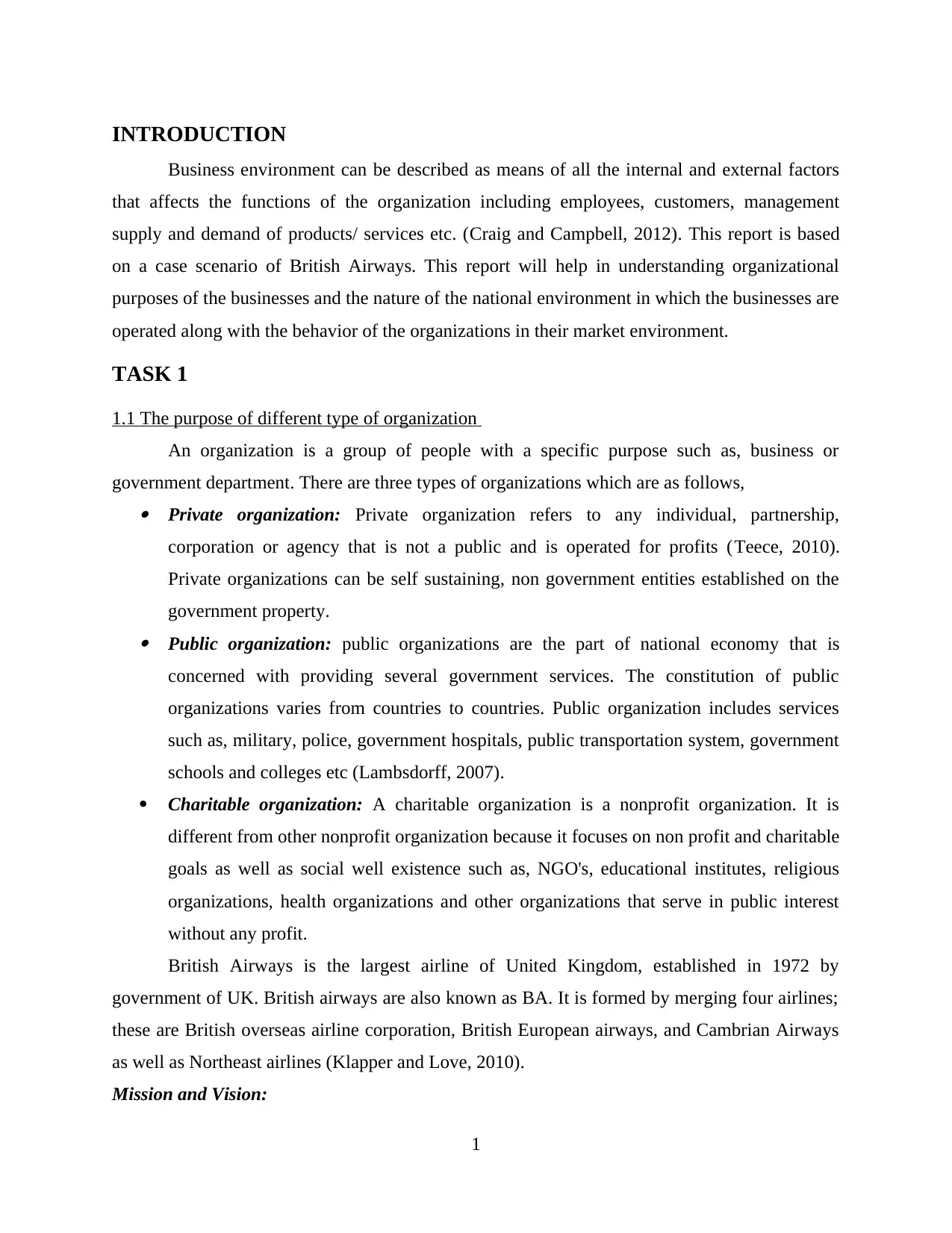
INTRODUCTION
Business environment can be described as means of all the internal and external factors
that affects the functions of the organization including employees, customers, management
supply and demand of products/ services etc. (Craig and Campbell, 2012). This report is based
on a case scenario of British Airways. This report will help in understanding organizational
purposes of the businesses and the nature of the national environment in which the businesses are
operated along with the behavior of the organizations in their market environment.
TASK 1
1.1 The purpose of different type of organization
An organization is a group of people with a specific purpose such as, business or
government department. There are three types of organizations which are as follows, Private organization: Private organization refers to any individual, partnership,
corporation or agency that is not a public and is operated for profits (Teece, 2010).
Private organizations can be self sustaining, non government entities established on the
government property. Public organization: public organizations are the part of national economy that is
concerned with providing several government services. The constitution of public
organizations varies from countries to countries. Public organization includes services
such as, military, police, government hospitals, public transportation system, government
schools and colleges etc (Lambsdorff, 2007).
Charitable organization: A charitable organization is a nonprofit organization. It is
different from other nonprofit organization because it focuses on non profit and charitable
goals as well as social well existence such as, NGO's, educational institutes, religious
organizations, health organizations and other organizations that serve in public interest
without any profit.
British Airways is the largest airline of United Kingdom, established in 1972 by
government of UK. British airways are also known as BA. It is formed by merging four airlines;
these are British overseas airline corporation, British European airways, and Cambrian Airways
as well as Northeast airlines (Klapper and Love, 2010).
Mission and Vision:
1
Business environment can be described as means of all the internal and external factors
that affects the functions of the organization including employees, customers, management
supply and demand of products/ services etc. (Craig and Campbell, 2012). This report is based
on a case scenario of British Airways. This report will help in understanding organizational
purposes of the businesses and the nature of the national environment in which the businesses are
operated along with the behavior of the organizations in their market environment.
TASK 1
1.1 The purpose of different type of organization
An organization is a group of people with a specific purpose such as, business or
government department. There are three types of organizations which are as follows, Private organization: Private organization refers to any individual, partnership,
corporation or agency that is not a public and is operated for profits (Teece, 2010).
Private organizations can be self sustaining, non government entities established on the
government property. Public organization: public organizations are the part of national economy that is
concerned with providing several government services. The constitution of public
organizations varies from countries to countries. Public organization includes services
such as, military, police, government hospitals, public transportation system, government
schools and colleges etc (Lambsdorff, 2007).
Charitable organization: A charitable organization is a nonprofit organization. It is
different from other nonprofit organization because it focuses on non profit and charitable
goals as well as social well existence such as, NGO's, educational institutes, religious
organizations, health organizations and other organizations that serve in public interest
without any profit.
British Airways is the largest airline of United Kingdom, established in 1972 by
government of UK. British airways are also known as BA. It is formed by merging four airlines;
these are British overseas airline corporation, British European airways, and Cambrian Airways
as well as Northeast airlines (Klapper and Love, 2010).
Mission and Vision:
1
⊘ This is a preview!⊘
Do you want full access?
Subscribe today to unlock all pages.

Trusted by 1+ million students worldwide
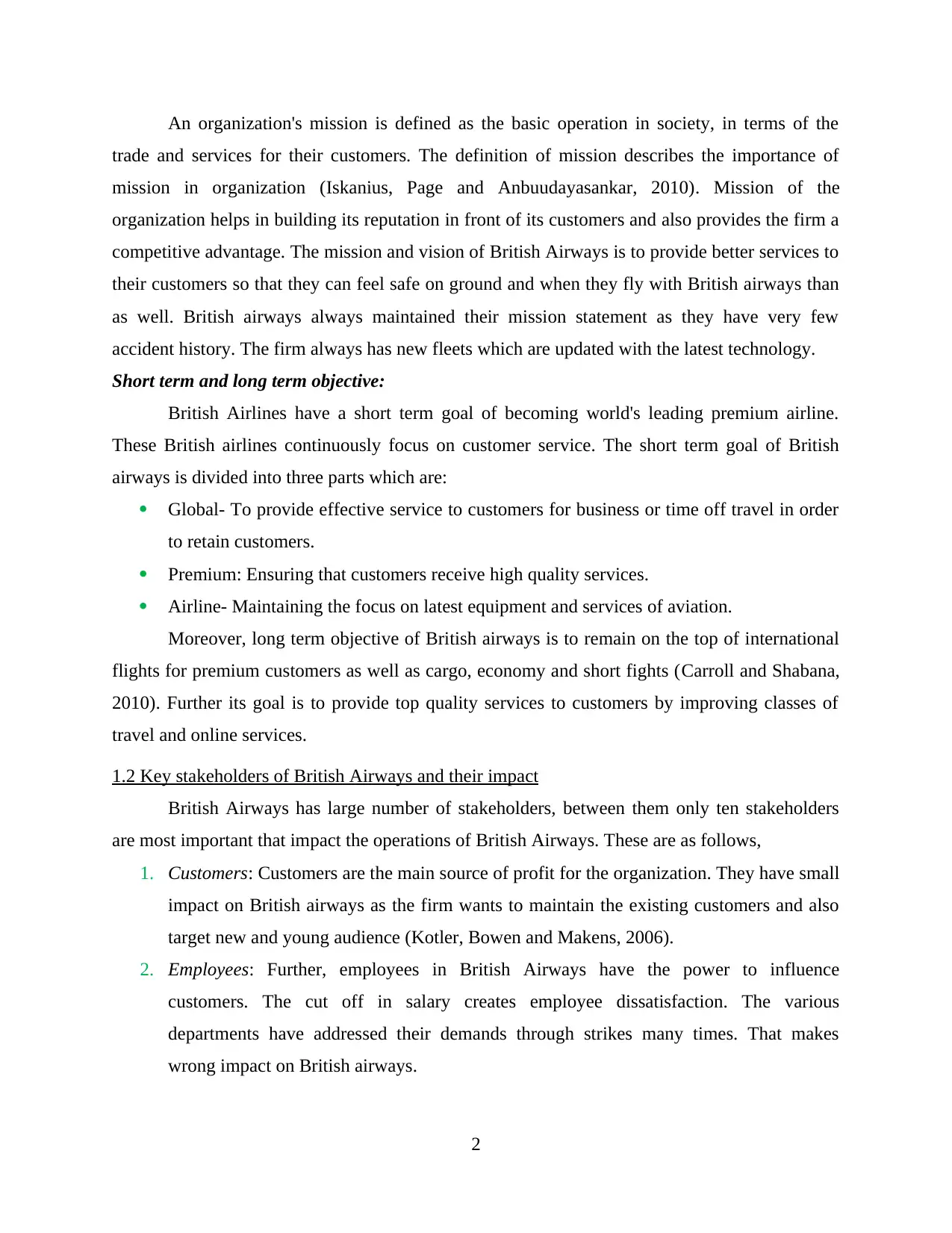
An organization's mission is defined as the basic operation in society, in terms of the
trade and services for their customers. The definition of mission describes the importance of
mission in organization (Iskanius, Page and Anbuudayasankar, 2010). Mission of the
organization helps in building its reputation in front of its customers and also provides the firm a
competitive advantage. The mission and vision of British Airways is to provide better services to
their customers so that they can feel safe on ground and when they fly with British airways than
as well. British airways always maintained their mission statement as they have very few
accident history. The firm always has new fleets which are updated with the latest technology.
Short term and long term objective:
British Airlines have a short term goal of becoming world's leading premium airline.
These British airlines continuously focus on customer service. The short term goal of British
airways is divided into three parts which are:
Global- To provide effective service to customers for business or time off travel in order
to retain customers.
Premium: Ensuring that customers receive high quality services.
Airline- Maintaining the focus on latest equipment and services of aviation.
Moreover, long term objective of British airways is to remain on the top of international
flights for premium customers as well as cargo, economy and short fights (Carroll and Shabana,
2010). Further its goal is to provide top quality services to customers by improving classes of
travel and online services.
1.2 Key stakeholders of British Airways and their impact
British Airways has large number of stakeholders, between them only ten stakeholders
are most important that impact the operations of British Airways. These are as follows,
1. Customers: Customers are the main source of profit for the organization. They have small
impact on British airways as the firm wants to maintain the existing customers and also
target new and young audience (Kotler, Bowen and Makens, 2006).
2. Employees: Further, employees in British Airways have the power to influence
customers. The cut off in salary creates employee dissatisfaction. The various
departments have addressed their demands through strikes many times. That makes
wrong impact on British airways.
2
trade and services for their customers. The definition of mission describes the importance of
mission in organization (Iskanius, Page and Anbuudayasankar, 2010). Mission of the
organization helps in building its reputation in front of its customers and also provides the firm a
competitive advantage. The mission and vision of British Airways is to provide better services to
their customers so that they can feel safe on ground and when they fly with British airways than
as well. British airways always maintained their mission statement as they have very few
accident history. The firm always has new fleets which are updated with the latest technology.
Short term and long term objective:
British Airlines have a short term goal of becoming world's leading premium airline.
These British airlines continuously focus on customer service. The short term goal of British
airways is divided into three parts which are:
Global- To provide effective service to customers for business or time off travel in order
to retain customers.
Premium: Ensuring that customers receive high quality services.
Airline- Maintaining the focus on latest equipment and services of aviation.
Moreover, long term objective of British airways is to remain on the top of international
flights for premium customers as well as cargo, economy and short fights (Carroll and Shabana,
2010). Further its goal is to provide top quality services to customers by improving classes of
travel and online services.
1.2 Key stakeholders of British Airways and their impact
British Airways has large number of stakeholders, between them only ten stakeholders
are most important that impact the operations of British Airways. These are as follows,
1. Customers: Customers are the main source of profit for the organization. They have small
impact on British airways as the firm wants to maintain the existing customers and also
target new and young audience (Kotler, Bowen and Makens, 2006).
2. Employees: Further, employees in British Airways have the power to influence
customers. The cut off in salary creates employee dissatisfaction. The various
departments have addressed their demands through strikes many times. That makes
wrong impact on British airways.
2
Paraphrase This Document
Need a fresh take? Get an instant paraphrase of this document with our AI Paraphraser
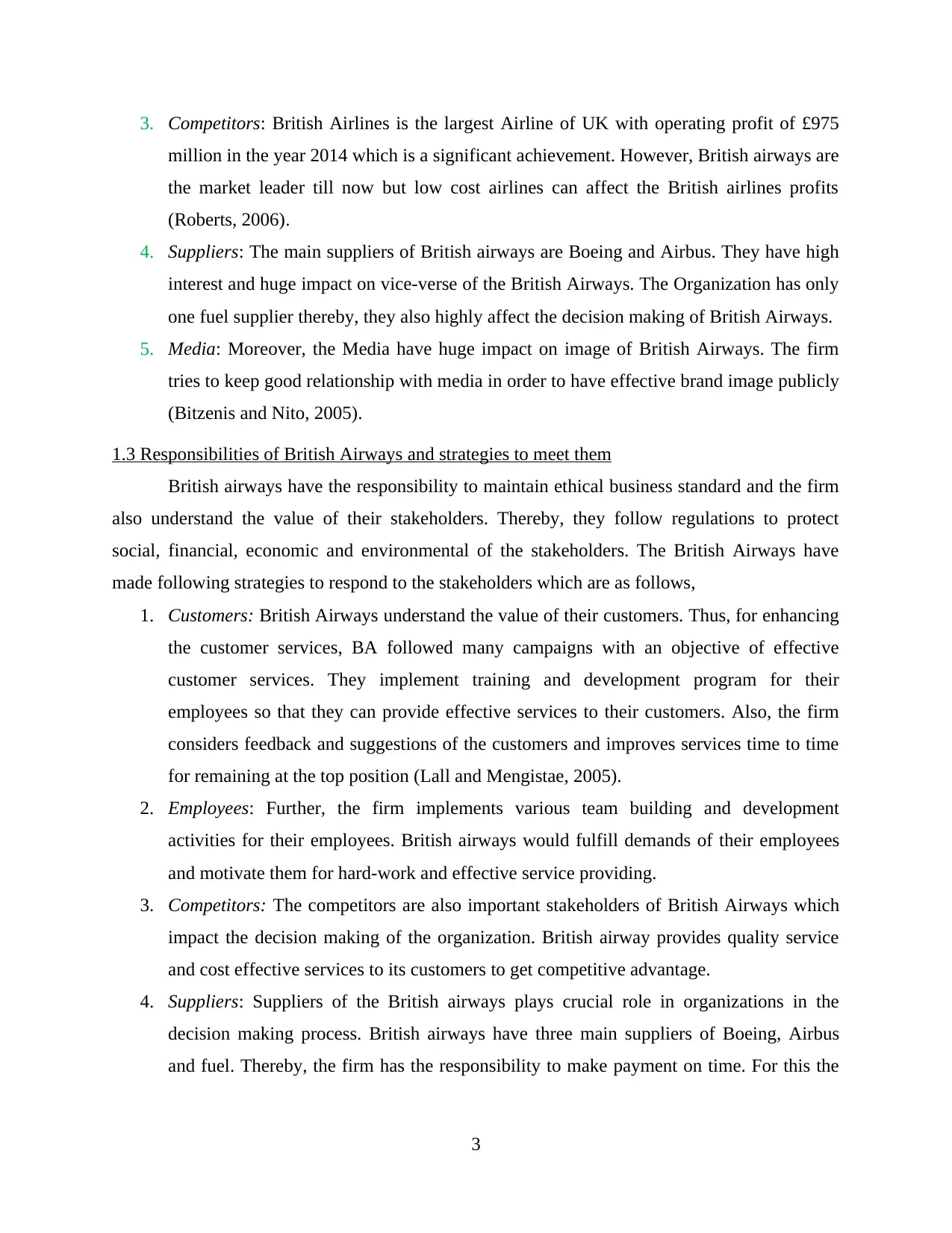
3. Competitors: British Airlines is the largest Airline of UK with operating profit of £975
million in the year 2014 which is a significant achievement. However, British airways are
the market leader till now but low cost airlines can affect the British airlines profits
(Roberts, 2006).
4. Suppliers: The main suppliers of British airways are Boeing and Airbus. They have high
interest and huge impact on vice-verse of the British Airways. The Organization has only
one fuel supplier thereby, they also highly affect the decision making of British Airways.
5. Media: Moreover, the Media have huge impact on image of British Airways. The firm
tries to keep good relationship with media in order to have effective brand image publicly
(Bitzenis and Nito, 2005).
1.3 Responsibilities of British Airways and strategies to meet them
British airways have the responsibility to maintain ethical business standard and the firm
also understand the value of their stakeholders. Thereby, they follow regulations to protect
social, financial, economic and environmental of the stakeholders. The British Airways have
made following strategies to respond to the stakeholders which are as follows,
1. Customers: British Airways understand the value of their customers. Thus, for enhancing
the customer services, BA followed many campaigns with an objective of effective
customer services. They implement training and development program for their
employees so that they can provide effective services to their customers. Also, the firm
considers feedback and suggestions of the customers and improves services time to time
for remaining at the top position (Lall and Mengistae, 2005).
2. Employees: Further, the firm implements various team building and development
activities for their employees. British airways would fulfill demands of their employees
and motivate them for hard-work and effective service providing.
3. Competitors: The competitors are also important stakeholders of British Airways which
impact the decision making of the organization. British airway provides quality service
and cost effective services to its customers to get competitive advantage.
4. Suppliers: Suppliers of the British airways plays crucial role in organizations in the
decision making process. British airways have three main suppliers of Boeing, Airbus
and fuel. Thereby, the firm has the responsibility to make payment on time. For this the
3
million in the year 2014 which is a significant achievement. However, British airways are
the market leader till now but low cost airlines can affect the British airlines profits
(Roberts, 2006).
4. Suppliers: The main suppliers of British airways are Boeing and Airbus. They have high
interest and huge impact on vice-verse of the British Airways. The Organization has only
one fuel supplier thereby, they also highly affect the decision making of British Airways.
5. Media: Moreover, the Media have huge impact on image of British Airways. The firm
tries to keep good relationship with media in order to have effective brand image publicly
(Bitzenis and Nito, 2005).
1.3 Responsibilities of British Airways and strategies to meet them
British airways have the responsibility to maintain ethical business standard and the firm
also understand the value of their stakeholders. Thereby, they follow regulations to protect
social, financial, economic and environmental of the stakeholders. The British Airways have
made following strategies to respond to the stakeholders which are as follows,
1. Customers: British Airways understand the value of their customers. Thus, for enhancing
the customer services, BA followed many campaigns with an objective of effective
customer services. They implement training and development program for their
employees so that they can provide effective services to their customers. Also, the firm
considers feedback and suggestions of the customers and improves services time to time
for remaining at the top position (Lall and Mengistae, 2005).
2. Employees: Further, the firm implements various team building and development
activities for their employees. British airways would fulfill demands of their employees
and motivate them for hard-work and effective service providing.
3. Competitors: The competitors are also important stakeholders of British Airways which
impact the decision making of the organization. British airway provides quality service
and cost effective services to its customers to get competitive advantage.
4. Suppliers: Suppliers of the British airways plays crucial role in organizations in the
decision making process. British airways have three main suppliers of Boeing, Airbus
and fuel. Thereby, the firm has the responsibility to make payment on time. For this the
3
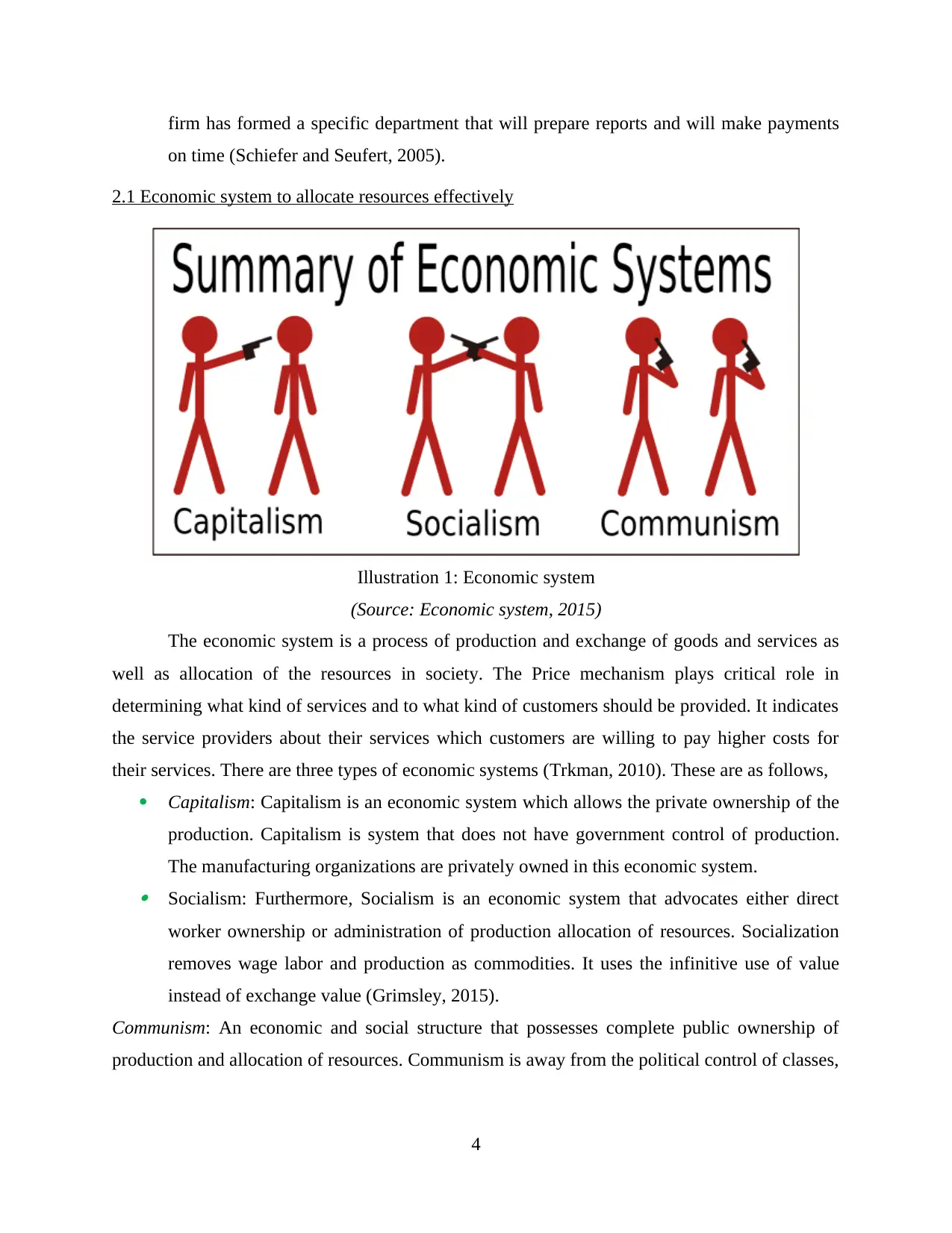
firm has formed a specific department that will prepare reports and will make payments
on time (Schiefer and Seufert, 2005).
2.1 Economic system to allocate resources effectively
The economic system is a process of production and exchange of goods and services as
well as allocation of the resources in society. The Price mechanism plays critical role in
determining what kind of services and to what kind of customers should be provided. It indicates
the service providers about their services which customers are willing to pay higher costs for
their services. There are three types of economic systems (Trkman, 2010). These are as follows,
Capitalism: Capitalism is an economic system which allows the private ownership of the
production. Capitalism is system that does not have government control of production.
The manufacturing organizations are privately owned in this economic system. Socialism: Furthermore, Socialism is an economic system that advocates either direct
worker ownership or administration of production allocation of resources. Socialization
removes wage labor and production as commodities. It uses the infinitive use of value
instead of exchange value (Grimsley, 2015).
Communism: An economic and social structure that possesses complete public ownership of
production and allocation of resources. Communism is away from the political control of classes,
4
Illustration 1: Economic system
(Source: Economic system, 2015)
on time (Schiefer and Seufert, 2005).
2.1 Economic system to allocate resources effectively
The economic system is a process of production and exchange of goods and services as
well as allocation of the resources in society. The Price mechanism plays critical role in
determining what kind of services and to what kind of customers should be provided. It indicates
the service providers about their services which customers are willing to pay higher costs for
their services. There are three types of economic systems (Trkman, 2010). These are as follows,
Capitalism: Capitalism is an economic system which allows the private ownership of the
production. Capitalism is system that does not have government control of production.
The manufacturing organizations are privately owned in this economic system. Socialism: Furthermore, Socialism is an economic system that advocates either direct
worker ownership or administration of production allocation of resources. Socialization
removes wage labor and production as commodities. It uses the infinitive use of value
instead of exchange value (Grimsley, 2015).
Communism: An economic and social structure that possesses complete public ownership of
production and allocation of resources. Communism is away from the political control of classes,
4
Illustration 1: Economic system
(Source: Economic system, 2015)
⊘ This is a preview!⊘
Do you want full access?
Subscribe today to unlock all pages.

Trusted by 1+ million students worldwide
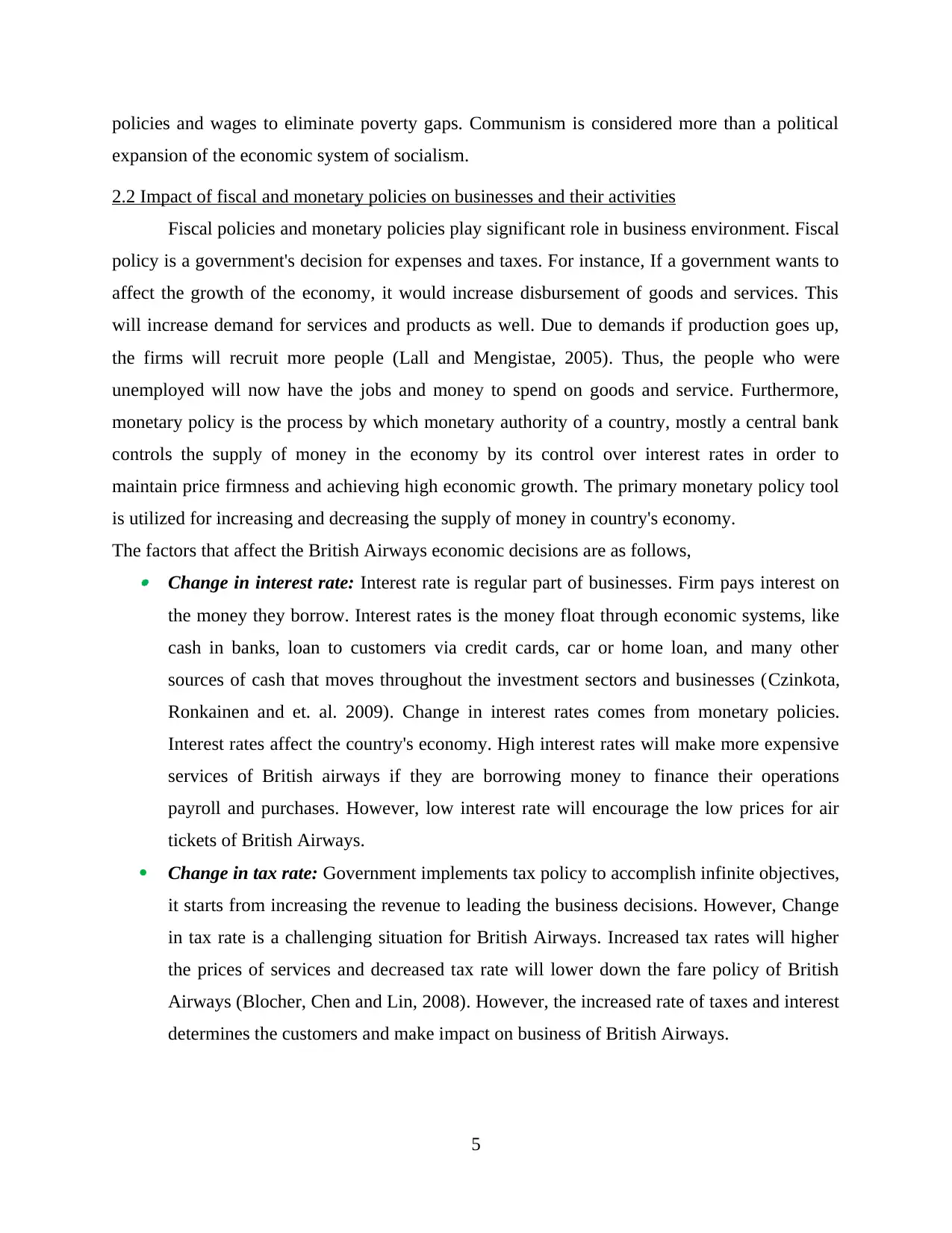
policies and wages to eliminate poverty gaps. Communism is considered more than a political
expansion of the economic system of socialism.
2.2 Impact of fiscal and monetary policies on businesses and their activities
Fiscal policies and monetary policies play significant role in business environment. Fiscal
policy is a government's decision for expenses and taxes. For instance, If a government wants to
affect the growth of the economy, it would increase disbursement of goods and services. This
will increase demand for services and products as well. Due to demands if production goes up,
the firms will recruit more people (Lall and Mengistae, 2005). Thus, the people who were
unemployed will now have the jobs and money to spend on goods and service. Furthermore,
monetary policy is the process by which monetary authority of a country, mostly a central bank
controls the supply of money in the economy by its control over interest rates in order to
maintain price firmness and achieving high economic growth. The primary monetary policy tool
is utilized for increasing and decreasing the supply of money in country's economy.
The factors that affect the British Airways economic decisions are as follows, Change in interest rate: Interest rate is regular part of businesses. Firm pays interest on
the money they borrow. Interest rates is the money float through economic systems, like
cash in banks, loan to customers via credit cards, car or home loan, and many other
sources of cash that moves throughout the investment sectors and businesses (Czinkota,
Ronkainen and et. al. 2009). Change in interest rates comes from monetary policies.
Interest rates affect the country's economy. High interest rates will make more expensive
services of British airways if they are borrowing money to finance their operations
payroll and purchases. However, low interest rate will encourage the low prices for air
tickets of British Airways.
Change in tax rate: Government implements tax policy to accomplish infinite objectives,
it starts from increasing the revenue to leading the business decisions. However, Change
in tax rate is a challenging situation for British Airways. Increased tax rates will higher
the prices of services and decreased tax rate will lower down the fare policy of British
Airways (Blocher, Chen and Lin, 2008). However, the increased rate of taxes and interest
determines the customers and make impact on business of British Airways.
5
expansion of the economic system of socialism.
2.2 Impact of fiscal and monetary policies on businesses and their activities
Fiscal policies and monetary policies play significant role in business environment. Fiscal
policy is a government's decision for expenses and taxes. For instance, If a government wants to
affect the growth of the economy, it would increase disbursement of goods and services. This
will increase demand for services and products as well. Due to demands if production goes up,
the firms will recruit more people (Lall and Mengistae, 2005). Thus, the people who were
unemployed will now have the jobs and money to spend on goods and service. Furthermore,
monetary policy is the process by which monetary authority of a country, mostly a central bank
controls the supply of money in the economy by its control over interest rates in order to
maintain price firmness and achieving high economic growth. The primary monetary policy tool
is utilized for increasing and decreasing the supply of money in country's economy.
The factors that affect the British Airways economic decisions are as follows, Change in interest rate: Interest rate is regular part of businesses. Firm pays interest on
the money they borrow. Interest rates is the money float through economic systems, like
cash in banks, loan to customers via credit cards, car or home loan, and many other
sources of cash that moves throughout the investment sectors and businesses (Czinkota,
Ronkainen and et. al. 2009). Change in interest rates comes from monetary policies.
Interest rates affect the country's economy. High interest rates will make more expensive
services of British airways if they are borrowing money to finance their operations
payroll and purchases. However, low interest rate will encourage the low prices for air
tickets of British Airways.
Change in tax rate: Government implements tax policy to accomplish infinite objectives,
it starts from increasing the revenue to leading the business decisions. However, Change
in tax rate is a challenging situation for British Airways. Increased tax rates will higher
the prices of services and decreased tax rate will lower down the fare policy of British
Airways (Blocher, Chen and Lin, 2008). However, the increased rate of taxes and interest
determines the customers and make impact on business of British Airways.
5
Paraphrase This Document
Need a fresh take? Get an instant paraphrase of this document with our AI Paraphraser
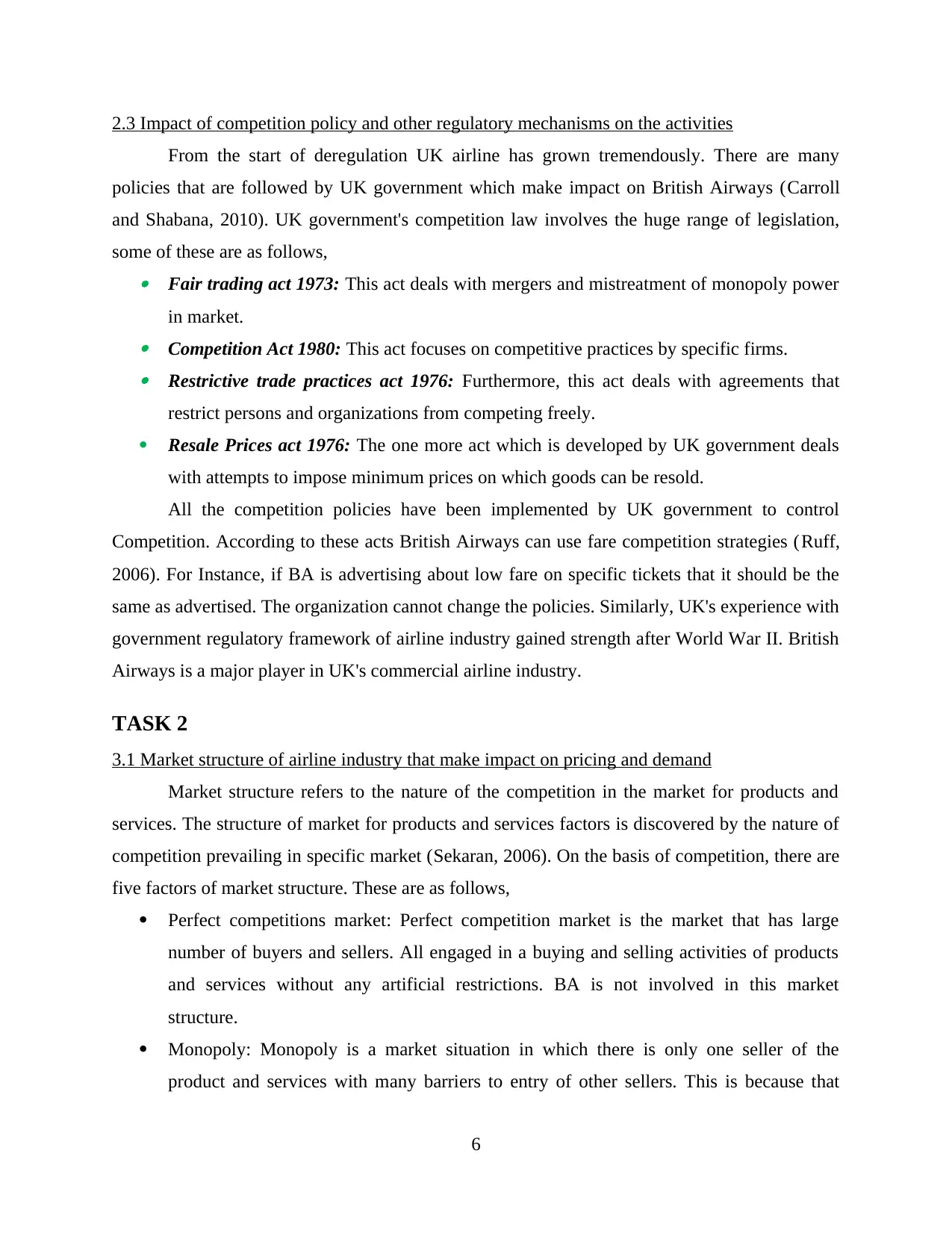
2.3 Impact of competition policy and other regulatory mechanisms on the activities
From the start of deregulation UK airline has grown tremendously. There are many
policies that are followed by UK government which make impact on British Airways (Carroll
and Shabana, 2010). UK government's competition law involves the huge range of legislation,
some of these are as follows, Fair trading act 1973: This act deals with mergers and mistreatment of monopoly power
in market. Competition Act 1980: This act focuses on competitive practices by specific firms. Restrictive trade practices act 1976: Furthermore, this act deals with agreements that
restrict persons and organizations from competing freely.
Resale Prices act 1976: The one more act which is developed by UK government deals
with attempts to impose minimum prices on which goods can be resold.
All the competition policies have been implemented by UK government to control
Competition. According to these acts British Airways can use fare competition strategies (Ruff,
2006). For Instance, if BA is advertising about low fare on specific tickets that it should be the
same as advertised. The organization cannot change the policies. Similarly, UK's experience with
government regulatory framework of airline industry gained strength after World War II. British
Airways is a major player in UK's commercial airline industry.
TASK 2
3.1 Market structure of airline industry that make impact on pricing and demand
Market structure refers to the nature of the competition in the market for products and
services. The structure of market for products and services factors is discovered by the nature of
competition prevailing in specific market (Sekaran, 2006). On the basis of competition, there are
five factors of market structure. These are as follows,
Perfect competitions market: Perfect competition market is the market that has large
number of buyers and sellers. All engaged in a buying and selling activities of products
and services without any artificial restrictions. BA is not involved in this market
structure.
Monopoly: Monopoly is a market situation in which there is only one seller of the
product and services with many barriers to entry of other sellers. This is because that
6
From the start of deregulation UK airline has grown tremendously. There are many
policies that are followed by UK government which make impact on British Airways (Carroll
and Shabana, 2010). UK government's competition law involves the huge range of legislation,
some of these are as follows, Fair trading act 1973: This act deals with mergers and mistreatment of monopoly power
in market. Competition Act 1980: This act focuses on competitive practices by specific firms. Restrictive trade practices act 1976: Furthermore, this act deals with agreements that
restrict persons and organizations from competing freely.
Resale Prices act 1976: The one more act which is developed by UK government deals
with attempts to impose minimum prices on which goods can be resold.
All the competition policies have been implemented by UK government to control
Competition. According to these acts British Airways can use fare competition strategies (Ruff,
2006). For Instance, if BA is advertising about low fare on specific tickets that it should be the
same as advertised. The organization cannot change the policies. Similarly, UK's experience with
government regulatory framework of airline industry gained strength after World War II. British
Airways is a major player in UK's commercial airline industry.
TASK 2
3.1 Market structure of airline industry that make impact on pricing and demand
Market structure refers to the nature of the competition in the market for products and
services. The structure of market for products and services factors is discovered by the nature of
competition prevailing in specific market (Sekaran, 2006). On the basis of competition, there are
five factors of market structure. These are as follows,
Perfect competitions market: Perfect competition market is the market that has large
number of buyers and sellers. All engaged in a buying and selling activities of products
and services without any artificial restrictions. BA is not involved in this market
structure.
Monopoly: Monopoly is a market situation in which there is only one seller of the
product and services with many barriers to entry of other sellers. This is because that
6
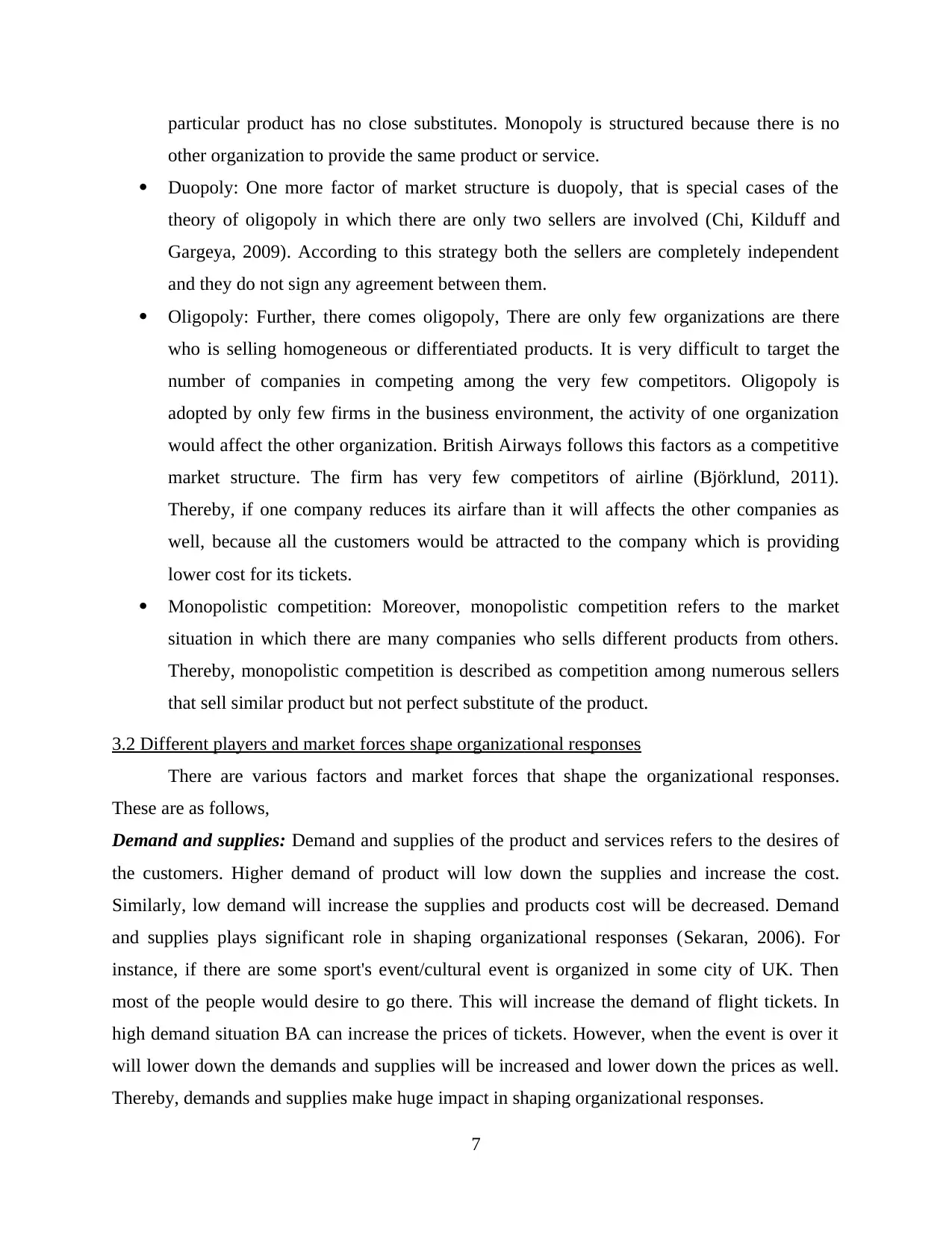
particular product has no close substitutes. Monopoly is structured because there is no
other organization to provide the same product or service.
Duopoly: One more factor of market structure is duopoly, that is special cases of the
theory of oligopoly in which there are only two sellers are involved (Chi, Kilduff and
Gargeya, 2009). According to this strategy both the sellers are completely independent
and they do not sign any agreement between them.
Oligopoly: Further, there comes oligopoly, There are only few organizations are there
who is selling homogeneous or differentiated products. It is very difficult to target the
number of companies in competing among the very few competitors. Oligopoly is
adopted by only few firms in the business environment, the activity of one organization
would affect the other organization. British Airways follows this factors as a competitive
market structure. The firm has very few competitors of airline (Björklund, 2011).
Thereby, if one company reduces its airfare than it will affects the other companies as
well, because all the customers would be attracted to the company which is providing
lower cost for its tickets.
Monopolistic competition: Moreover, monopolistic competition refers to the market
situation in which there are many companies who sells different products from others.
Thereby, monopolistic competition is described as competition among numerous sellers
that sell similar product but not perfect substitute of the product.
3.2 Different players and market forces shape organizational responses
There are various factors and market forces that shape the organizational responses.
These are as follows,
Demand and supplies: Demand and supplies of the product and services refers to the desires of
the customers. Higher demand of product will low down the supplies and increase the cost.
Similarly, low demand will increase the supplies and products cost will be decreased. Demand
and supplies plays significant role in shaping organizational responses (Sekaran, 2006). For
instance, if there are some sport's event/cultural event is organized in some city of UK. Then
most of the people would desire to go there. This will increase the demand of flight tickets. In
high demand situation BA can increase the prices of tickets. However, when the event is over it
will lower down the demands and supplies will be increased and lower down the prices as well.
Thereby, demands and supplies make huge impact in shaping organizational responses.
7
other organization to provide the same product or service.
Duopoly: One more factor of market structure is duopoly, that is special cases of the
theory of oligopoly in which there are only two sellers are involved (Chi, Kilduff and
Gargeya, 2009). According to this strategy both the sellers are completely independent
and they do not sign any agreement between them.
Oligopoly: Further, there comes oligopoly, There are only few organizations are there
who is selling homogeneous or differentiated products. It is very difficult to target the
number of companies in competing among the very few competitors. Oligopoly is
adopted by only few firms in the business environment, the activity of one organization
would affect the other organization. British Airways follows this factors as a competitive
market structure. The firm has very few competitors of airline (Björklund, 2011).
Thereby, if one company reduces its airfare than it will affects the other companies as
well, because all the customers would be attracted to the company which is providing
lower cost for its tickets.
Monopolistic competition: Moreover, monopolistic competition refers to the market
situation in which there are many companies who sells different products from others.
Thereby, monopolistic competition is described as competition among numerous sellers
that sell similar product but not perfect substitute of the product.
3.2 Different players and market forces shape organizational responses
There are various factors and market forces that shape the organizational responses.
These are as follows,
Demand and supplies: Demand and supplies of the product and services refers to the desires of
the customers. Higher demand of product will low down the supplies and increase the cost.
Similarly, low demand will increase the supplies and products cost will be decreased. Demand
and supplies plays significant role in shaping organizational responses (Sekaran, 2006). For
instance, if there are some sport's event/cultural event is organized in some city of UK. Then
most of the people would desire to go there. This will increase the demand of flight tickets. In
high demand situation BA can increase the prices of tickets. However, when the event is over it
will lower down the demands and supplies will be increased and lower down the prices as well.
Thereby, demands and supplies make huge impact in shaping organizational responses.
7
⊘ This is a preview!⊘
Do you want full access?
Subscribe today to unlock all pages.

Trusted by 1+ million students worldwide
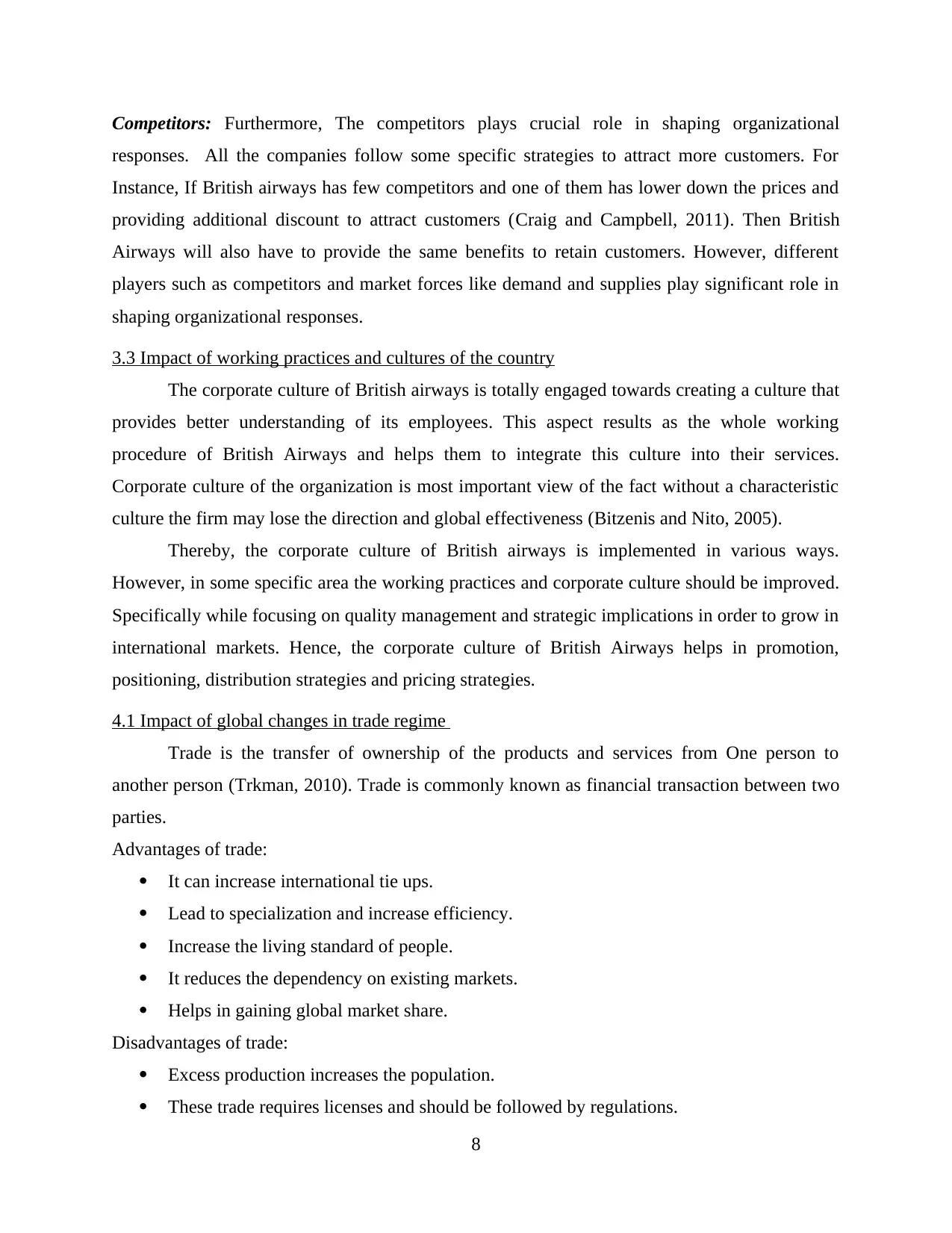
Competitors: Furthermore, The competitors plays crucial role in shaping organizational
responses. All the companies follow some specific strategies to attract more customers. For
Instance, If British airways has few competitors and one of them has lower down the prices and
providing additional discount to attract customers (Craig and Campbell, 2011). Then British
Airways will also have to provide the same benefits to retain customers. However, different
players such as competitors and market forces like demand and supplies play significant role in
shaping organizational responses.
3.3 Impact of working practices and cultures of the country
The corporate culture of British airways is totally engaged towards creating a culture that
provides better understanding of its employees. This aspect results as the whole working
procedure of British Airways and helps them to integrate this culture into their services.
Corporate culture of the organization is most important view of the fact without a characteristic
culture the firm may lose the direction and global effectiveness (Bitzenis and Nito, 2005).
Thereby, the corporate culture of British airways is implemented in various ways.
However, in some specific area the working practices and corporate culture should be improved.
Specifically while focusing on quality management and strategic implications in order to grow in
international markets. Hence, the corporate culture of British Airways helps in promotion,
positioning, distribution strategies and pricing strategies.
4.1 Impact of global changes in trade regime
Trade is the transfer of ownership of the products and services from One person to
another person (Trkman, 2010). Trade is commonly known as financial transaction between two
parties.
Advantages of trade:
It can increase international tie ups.
Lead to specialization and increase efficiency.
Increase the living standard of people.
It reduces the dependency on existing markets.
Helps in gaining global market share.
Disadvantages of trade:
Excess production increases the population.
These trade requires licenses and should be followed by regulations.
8
responses. All the companies follow some specific strategies to attract more customers. For
Instance, If British airways has few competitors and one of them has lower down the prices and
providing additional discount to attract customers (Craig and Campbell, 2011). Then British
Airways will also have to provide the same benefits to retain customers. However, different
players such as competitors and market forces like demand and supplies play significant role in
shaping organizational responses.
3.3 Impact of working practices and cultures of the country
The corporate culture of British airways is totally engaged towards creating a culture that
provides better understanding of its employees. This aspect results as the whole working
procedure of British Airways and helps them to integrate this culture into their services.
Corporate culture of the organization is most important view of the fact without a characteristic
culture the firm may lose the direction and global effectiveness (Bitzenis and Nito, 2005).
Thereby, the corporate culture of British airways is implemented in various ways.
However, in some specific area the working practices and corporate culture should be improved.
Specifically while focusing on quality management and strategic implications in order to grow in
international markets. Hence, the corporate culture of British Airways helps in promotion,
positioning, distribution strategies and pricing strategies.
4.1 Impact of global changes in trade regime
Trade is the transfer of ownership of the products and services from One person to
another person (Trkman, 2010). Trade is commonly known as financial transaction between two
parties.
Advantages of trade:
It can increase international tie ups.
Lead to specialization and increase efficiency.
Increase the living standard of people.
It reduces the dependency on existing markets.
Helps in gaining global market share.
Disadvantages of trade:
Excess production increases the population.
These trade requires licenses and should be followed by regulations.
8
Paraphrase This Document
Need a fresh take? Get an instant paraphrase of this document with our AI Paraphraser

Lead towards economical ideology.
It can lead towards international debt.
International trade incurred additional costs.
International trade is essential for British Airways allows it to gain comparative
advantage. According to this if British Airways is not able to provide services in some particular
area than it can take advantage of the trade.
4.2 Global factors that affects the British Airways
Global factors have significant issue for organizations while operating business
internationally. The various global factors that make impact of British airways are as follows, International competitiveness: British Airways is a public organization of UK and
operating its business in many other countries as well. Thereby, the firm needs to
consider international competitors. International business environment: Further, while operating business internationally
the firm needs to consider all the political, economic, social, technological, legal and
environmental factors of the particular country (Iskanius, Page and Anbuudayasankar,
2010). These factors are the important part of business environment which directly make
impact in international market.
Tax rates: Moreover, Other global factor that can affect the business of British airways is
the tax rate of the country. The rate of taxes varied from country to country. These
changed rate would generate changed prices in services as well.
4.3 Impact of the policies of the European Union
European Union has some rules and regulations which member countries have to
maintain while functioning various business activities in home country and internationally.
Major policies that is taken by European Union are as follows,
Employment policy
Regional policy
Inflation policy
Education and training policy
Taxation Policy
These policies make direct impact on business activities of British Airways. While doing
international business BA has to consider all policies imposed by European Union otherwise the
9
It can lead towards international debt.
International trade incurred additional costs.
International trade is essential for British Airways allows it to gain comparative
advantage. According to this if British Airways is not able to provide services in some particular
area than it can take advantage of the trade.
4.2 Global factors that affects the British Airways
Global factors have significant issue for organizations while operating business
internationally. The various global factors that make impact of British airways are as follows, International competitiveness: British Airways is a public organization of UK and
operating its business in many other countries as well. Thereby, the firm needs to
consider international competitors. International business environment: Further, while operating business internationally
the firm needs to consider all the political, economic, social, technological, legal and
environmental factors of the particular country (Iskanius, Page and Anbuudayasankar,
2010). These factors are the important part of business environment which directly make
impact in international market.
Tax rates: Moreover, Other global factor that can affect the business of British airways is
the tax rate of the country. The rate of taxes varied from country to country. These
changed rate would generate changed prices in services as well.
4.3 Impact of the policies of the European Union
European Union has some rules and regulations which member countries have to
maintain while functioning various business activities in home country and internationally.
Major policies that is taken by European Union are as follows,
Employment policy
Regional policy
Inflation policy
Education and training policy
Taxation Policy
These policies make direct impact on business activities of British Airways. While doing
international business BA has to consider all policies imposed by European Union otherwise the
9
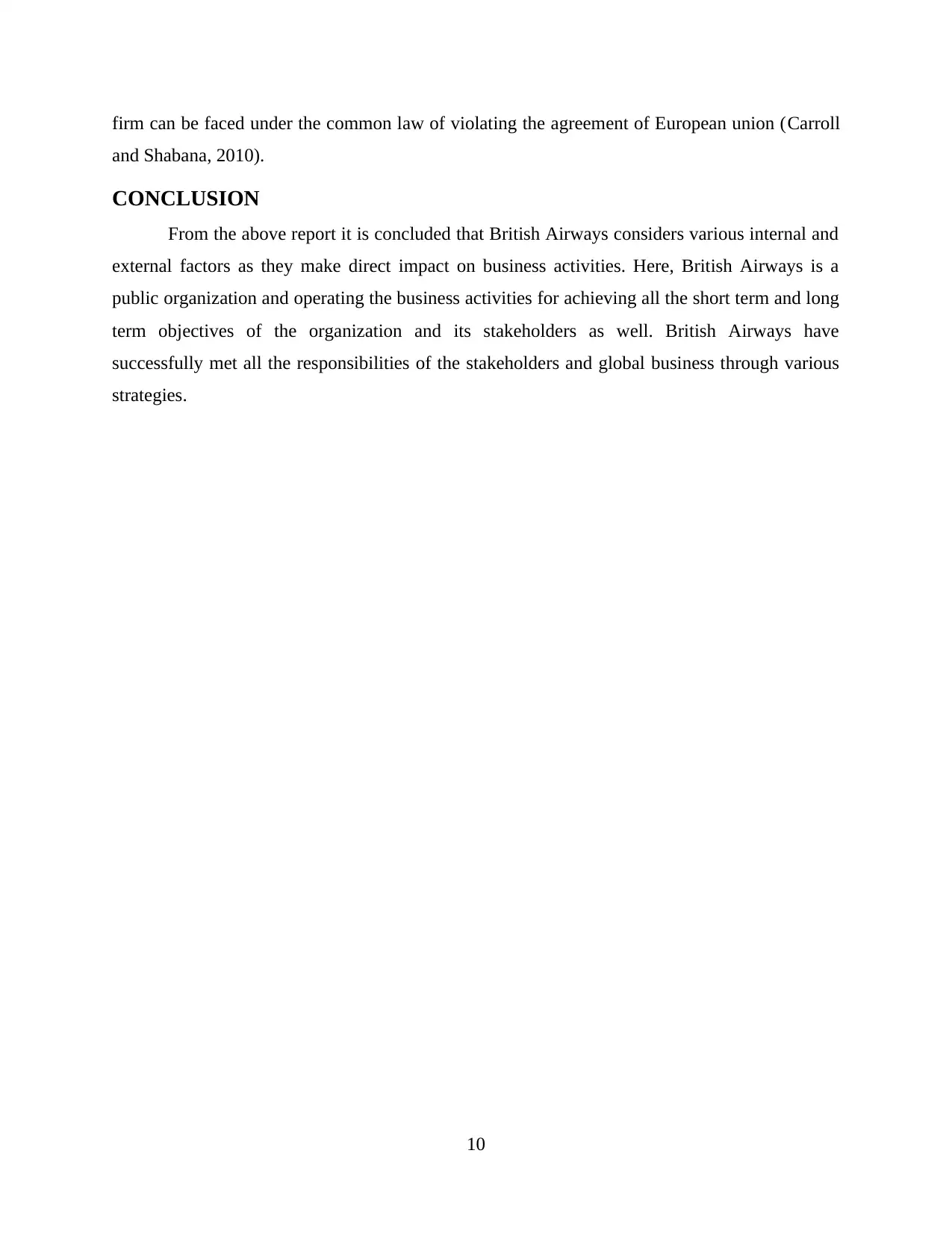
firm can be faced under the common law of violating the agreement of European union (Carroll
and Shabana, 2010).
CONCLUSION
From the above report it is concluded that British Airways considers various internal and
external factors as they make direct impact on business activities. Here, British Airways is a
public organization and operating the business activities for achieving all the short term and long
term objectives of the organization and its stakeholders as well. British Airways have
successfully met all the responsibilities of the stakeholders and global business through various
strategies.
10
and Shabana, 2010).
CONCLUSION
From the above report it is concluded that British Airways considers various internal and
external factors as they make direct impact on business activities. Here, British Airways is a
public organization and operating the business activities for achieving all the short term and long
term objectives of the organization and its stakeholders as well. British Airways have
successfully met all the responsibilities of the stakeholders and global business through various
strategies.
10
⊘ This is a preview!⊘
Do you want full access?
Subscribe today to unlock all pages.

Trusted by 1+ million students worldwide
1 out of 14
Related Documents
Your All-in-One AI-Powered Toolkit for Academic Success.
+13062052269
info@desklib.com
Available 24*7 on WhatsApp / Email
![[object Object]](/_next/static/media/star-bottom.7253800d.svg)
Unlock your academic potential
Copyright © 2020–2025 A2Z Services. All Rights Reserved. Developed and managed by ZUCOL.





